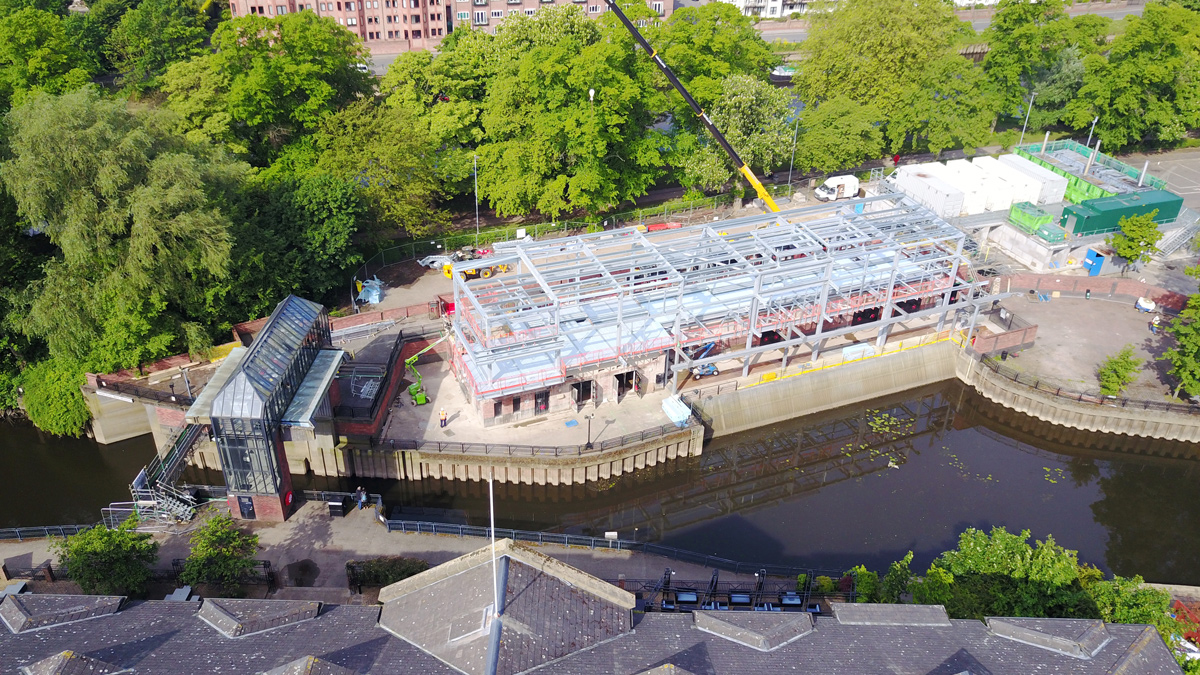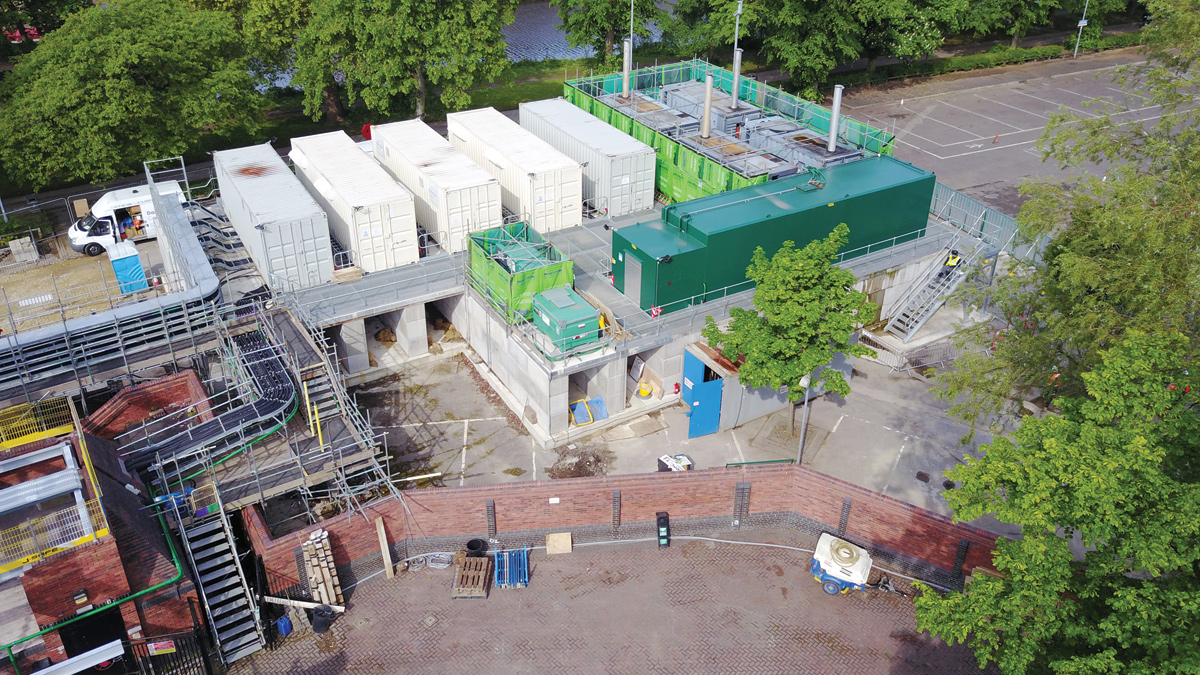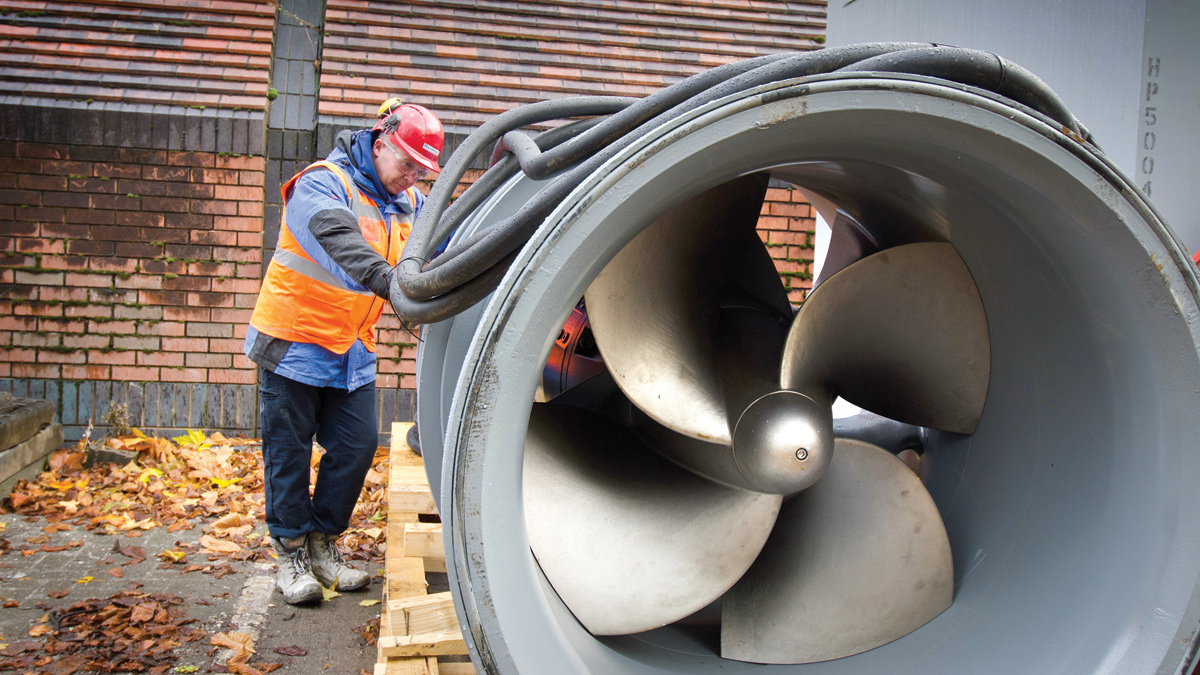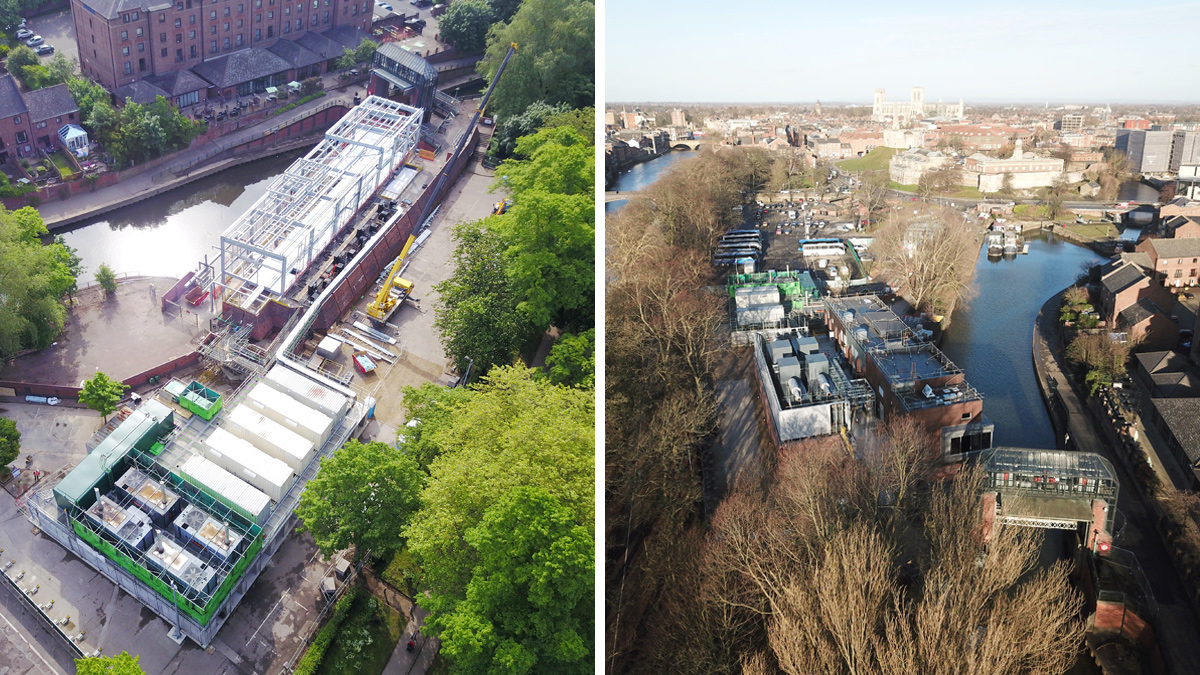Foss Barrier (2019)

Aerial View of the Foss Barrier scheme - courtesy of MMB
In December 2015, the most severe floods in a generation hit the City of York. As water levels rose to the highest recorded on the River Foss, they entered the main control building at the Foss Barrier, which forms an important part of the city’s flood defences, rendering the facility inoperable. The Foss Barrier and pumping station were built in the 1980s in response to severe flooding five years previous. In flood conditions, a mechanical gate can be closed to stop rising waters in the River Ouse from backing up into the River Foss, preventing flooding to large parts of the city. When the barrier is down, the facility relies on up to eight pumps to transfer flows from the River Foss around the barrier into the River Ouse.
Introduction
After significant involvement in the initial emergency flood response, JBA Bentley (JBAB) – a joint venture between JBA Consulting and JN Bentley – was engaged to deliver the high-profile upgrade to the site, with the key objective being to enhance the overall resilience and capacity of the site, whilst critically ensuring the pump station remained operational throughout.
Working in challenging conditions on a constrained site, with extremely tight timescales, clever civil engineering and an innovative approach to temporary works has been pivotal to the success of the scheme. Although some elements of work are still outstanding, the pumping station is now fully operational from the new building and provides enhanced flood protection and peace of mind to the residents of York.
Temporary works installation
Within three months of the incident ,and having fully developed the civils design in a much shorter time-frame than usual, construction works began on an innovative 3m high temporary platform to raise all temporary and permanent MEICA (mechanical, electrical, instrumentation, control and automation) equipment above the highest flood level.
Following design checks, JBAB was able to construct the temporary platform in the existing car park, which aided speedier construction and avoided costly and timely ground preparation.
JBAB then turned to an innovative solution for the platform itself, using 596 (No.) precast Legato interlocking concrete blocks. Constructed within the flood plain, the use of the blocks and permanent soffit formwork minimised the reduction in storage capacity and enabled a safer, quicker working method. The 540m2 platform was constructed in little more than eight weeks.

Site set up – Courtesy of MMB
To construct the temporary platform, JBAB:
- Ensured greater resilience to the existing asset; critical equipment was quickly raised above the highest flood level, providing protection above a 1:1000 year flood event.
- Allowed the permanent solution to be built off-line, making for a more efficient and safer build, eliminating plant, people and construction interfaces on site.
- Maintained a working pumping station throughout construction of the permanent works; a pre-requisite of the solution and critical for the client and public alike.
- Enabled early procurement of permanent MEICA equipment. Tthe platform safely housed the equipment in shipping containers until it could be re-located in the permanent facility.
- Allowed the platform to be delivered in two phases, enabling the early relocation of existing control equipment, and the handover of equipment to the client’s MEICA contractor.
- Avoided excessive temporary works. The use of precast and permanent soffit formwork reduced TW requirements when compared to more traditional construction.
The Legato blocks have the added advantage of being reusable elsewhere once works are complete, significantly reducing waste. The platform removal is currently underway in May 2019, with the blocks going on to provide flood protection on other similar projects.
Early permanent pump installation
It was critical to increase pump capacity ahead of the winter of 2016. Preventing another significant flood event was the main driver for the scheme, so providing additional protection at the earliest opportunity was paramount to all involved.
The swift construction of the temporary platform meant that new long-lead pumps and drives could be procured and installed early without any building modifications. The pump drives, temporarily located within shipping containers, were installed on the platform, and eight new pumps, capable of increasing the pumping capacity from 30 to 40 cumecs (m3/s) were installed within the existing wells. This was completed in September 2016.

Installation of new permanent pumps – Courtesy of MMB
Permanent works – the main build
The construction of a single-storey extension above the existing building and new generator platform to house all the new MEICA equipment. Construction has progressed unimpeded by existing structures on site, demonstrating the success and flexibility an off-line approach affords. Works are due for completion in Q4, 2019.
Foss Barrier: Supply chain – key particpants
- Permanent works design: Jacobs
- Interim design: JBA Bentley
- Principal contractor: JBA Bentley
- Structural steelwork: ECS Engineering Services
- Cladding: Roofclad Systems
- Piling: Roger Bullivant
- HV Switchgear: Schneider Electric
- HV transformers: Wilson Power Solutions
- Pumps and VSDs: Xylem Water Solutions
- MCC & systems integration: Blackburn Starling Ltd
M&E installation: AMCO Giffen - Weedscreen: Ovivo
- Mechanical hoist system: Qualter Hall
- Generators & fuel system: Yorpower
Full pumping capacity achieved
Whilst the permanent works continue towards a fully integrated site, full pumping capacity was achieved in February 2018. The maximum capacity with all 8 (No.) pumps running simultaneously is 50m3/s (50,000L/s). This would empty an Olympic size swimming pool in 50 seconds. This pumping capacity is an increase of 20m3/s and provides enhanced flood protection to the residents and businesses of York.
Client satisfaction
Successfully delivering a scheme of this value and complexity in just a third of the time of a ‘normal’ project has been challenging, but has been done so safely, on budget, and to a high standard. With speed a priority, quickly reacting to design outputs was key to ensure continuity of site work. As the defined scope of the project developed over time, project cost control measures were supplemented by regular risk control meetings. Each month revised forecasts were submitted and discussed. This better understanding of cash flow, risks and challenge has helped increase confidence in overall project costs.
The co-location of the client, design, contractor and MEICA specialists from day one has been crucial to the success of the project. With the fast-moving nature of this scheme, it is paramount to have key decision makers on site working together. The collaboration shown throughout was well recognised on a recent visit from Bernadette Carr, Director of Operations, Environment Agency, who stated: “very good partnership working between contractors and EA – a culture based on trust and openness.”
Given the magnitude of the floods on Boxing Day 2015 and the devastation they caused, the scheme is being delivered very much in the public eye and is one of the Environment Agency’s most high-profile sites. Situated in the centre of York with many different stakeholders, the solution is delivering multiple benefits to all, which means customer and stakeholder satisfaction has been a critical consideration throughout, with diligent project communication across many platforms forming a key aspect of the core team liaison activities.
One of the most significant stakeholder groups have been the residents of York themselves, who endured the destructive flooding in December 2015. Therefore, extensive effort has been made regarding stakeholder engagement, including site visits from a variety of parties, including:
- The Secretary of State.
- CIWEM (Chartered Institution of Water & Environmental Management).
- Rotary Club.
- Local Councillors.
- Friends of New Walk.
- Women in Property (WIP).
- Leeds Becket University.
- Acomb Primary School.
- The IET (Institution of Engineering and Technology).
JBAB’s open approach has helped facilitate the works, and enabled stakeholders to understand the scheme and the benefits it delivers. Numerous public events have been held on the site, allowing visitors access to the facility and to identify and understand the wider scheme objectives and delivery model. JBAB have also hosted several educational visits for local universities and the wider industry, introducing them to flood risk management, construction and the specifics of the Foss Barrier solution. JBAB are a registered considerate constructor and the Foss Barrier Project is widely acknowledged to have been successful by the populous of York.

(left) Aerial view of the Foss Barrier scheme and (right) Image showing close proximity of scheme to the centre of the City of York – courtesy of MMB
Quality, environment & safety
JBA Bentley have a rigorous and proactive approach to health and safety. The corporate health and safety strategy is underpinned by the phrase “if we cannot do it safely, we will not do it”.
Short cuts are not taken and the goal is to deliver more for the client for the same, or less money. At The Foss Barrier, the end user requirements were challenged, making it clear what items of work were essential to provide the right product, and which of those specified were ‘nice to have’. The temporary pumping station was planned strategically to ensure it could be operated and maintained without compromise when refurbishing the permanent station.
Opportunities using the permanent MEICA equipment as part of the temporary station were realised, minimising temporary or abortive purchases and maximising value to the client as well as providing early enhanced protection to the city of York.
At strategic level, the driver for the scheme itself was to reduce the environmental impacts caused by flooding – the city of York needed its critical flood defences reinstating and enhancing in double-quick time to guard against a repeat of the 2015 floods. Whilst this objective was realised, the team also needed to ensure the existing level of protection was maintained by the scheme.
Several options were considered to achieve this, including the total replacement of the station. However, the option to refurbish the existing station was taken forward as it greatly reduced the impact on the local environment, reduced risks associated with key issues in York, such as archaeology and strict planning conditions and was determined to provide a lower carbon solution.
Conclusion
It has only been possible to achieve everything to date through the hard work, determination and diligence of the entire project team. As JBAB close in on successful practical completion, the team recognise that the challenges have been faced head-on, driving towards achieving the key objective of enhancing the resilience and capacity of the site and protecting the people of York.
The project increases pumping capacity by 55% and provides increased protection to over 1,000 properties. The key message to share with the industry is one of ‘delivering at pace’.
The refurbished pumping station was delivered in a third of the usual time by:
- Early contractor and subcontractor engagement with the design team streamlined design and construction.
- Construction-led programme allowed early procurement of long lead items.
- Additional works instructed through PMIs, allowed the team to start on site earlier than traditional contracts.
- Collaborative review on design, driving safety and efficiency and embedding a ‘right first time’ culture.
- Early focus on key output requirements enabled work to be programmed in phases, this ensured the increased capacity of the pumping station was achieved as early as possible.
- Offline construction enabled the pumping station to remain operational throughout and expediting the permanent works with minimal interface issues.






